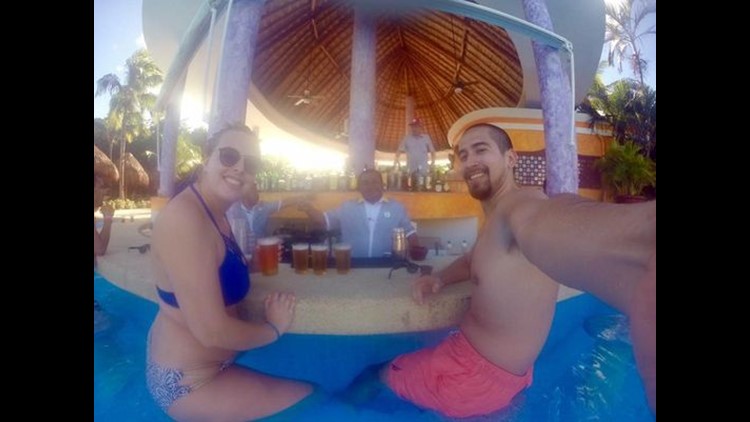Four days before Abbey Conner was found floating face down in a pool at a Mexican resort, Mary Jo Kuhn waded over to a swim-up bar in the same complex.
On her second drink, she blacked out.
Four days after Conner was pulled from the water, Meghan Gordon and her boyfriend were sitting on stools at the same swim-up bar where Conner and her brother had been drinking tequila on a family vacation.
Throughout the afternoon, a friendly bartender served Gordon and her boyfriend a couple mixed drinks, then two rounds of tequila shots.
Neither can remember what happened next — vomiting and being escorted away by hotel security.
The two incidents are among more than three dozen that have surfaced in the wake of a Milwaukee Journal Sentinel investigation this month into the death of 20-year-old Abbey Conner at the Iberostar Paraiso del Mar in Playa del Carmen in January.
Travelers from around the country have called and emailed the Journal Sentinel, describing similar incidents at numerous resorts in Mexico and providing documentation for their stories.
They describe how they got sick and blacked-out — many times after just two drinks — while vacationing at the upscale all-inclusive resorts in the region around Cancun, Playa del Carmen and Cozumel, as well as in Cabo San Lucas and Puerto Vallarta.
Some were robbed, sexually assaulted and otherwise seriously injured. Many were hospitalized. Some said they were forced to pay clinics huge sums in cash before getting treatment.
Others can find no apparent motive for why they might have received tainted or “spiked” alcohol.
The president of Mexico’s health commission, Sen. Salvador López Brito, said in an interview that the legislature is working on an “initiative to improve the controls and inspections for tainted alcohol at resorts.”
The legislative plans will be presented in September, Brito said, without providing additional details.
Meanwhile, Apple Vacations, which books trips for a half million vacationers to Mexico every year, said Thursday it will increase its efforts to ensure the resorts it works with are complying with alcohol procurement and other federal regulations.
In addition, Apple Vacations said it will push for hotels and resorts to install cameras in key public areas such as swimming pools and bars.
Travelers, including Conner’s parents, told the Journal Sentinel the resorts claim they have no surveillance cameras and thus no video evidence of accidents or crimes that take place on their property.
“Even though Apple Vacations does not own or operate the hotels, we will be recommending that all the properties to which we send guests, review their safety and security procedures and consider taking additional measures,” the company said in a written statement.
Earlier this week, the U.S. State Department updated its health and safety notice for Mexico, warning travelers of concerns about tainted and counterfeit alcohol.
Abbey Conner of Pewaukee was on a family vacation and was at the pool less than two hours before being found unconscious. Her brother, Austin, 22 at the time, was drowning next to her when they were spotted by someone who summoned help.


Austin had a lump on his head, a severe concussion and no recollection of what happened. Abbey was brain dead. Medics later discovered she had a broken collar bone. Tests from the local hospital stated that her blood-alcohol level was .25. His was .26, the hospital report said.
The circumstances surrounding her death and the way it was handled by the resort, local police and the hospital — which has a contract with the resort — prompted the Journal Sentinel’s investigation.
Expert: Multiple possible drugs
What could make two people black out at the same time — as many couples reported —somehow wind up back in their hotel rooms, and wake up hours later with no memory of what happened?
Matthew Johnson, an associate professor at Johns Hopkins School of Medicine, has no direct evidence, but the stories point to several likely possibilities: scopolamine, phencyclidine (better known as PCP) or methaqualone (quaaludes, a drug popular in the 1970s).
Based on the many accounts vacationers described, any of those drugs seems to make sense, said Johnson, a specialist in behavioral pharmacology.
They all can cause people to be “awake” but not know, or remember, what they’re doing. When mixed with alcohol, the effects are exacerbated and can cause all kinds of physical and psychological reactions.
Scopolamine, also called “Devil’s breath,” has been widely used in crimes in Colombia, where it is derived from the borrachero tree. In powder form added to a drink, it can lead to hallucinations, frightening images, and loss of free will. And it’s known to cause amnesia.
Several people interviewed by the Journal Sentinel said they recalled being terrified. They couldn’t say exactly why.
“When people say it’s the 'zombie drug,' that’s not an exaggeration,” Johnson said. “It’s not a drug of abuse. People don’t like to get high on it.”
Low doses of scopolamine also come in patches that are prescribed by doctors to help with motion sickness.
One couple from North Carolina interviewed by the Journal Sentinel said they were wearing the patches in March while on a snorkeling excursion in Cozumel. Like others, they had a few drinks. The last thing they remember is vomiting. Neither has any idea how they made it back to their cruise ship cabin.
They woke up hours later and felt lucky to be alive. One had a large bruise on her thigh. Both her knees were scrapped and bloody.
PCP came to mind when Johnson learned some of the people also reported that they had gone into a rage. Also known as "angel dust," PCP causes hallucinations, slurred speech, staggering and other symptoms that resemble intoxication.
Meg Ward was taken to the hospital after she and a friend were drinking shots at the Grand Oasis Tulum in June. She was foaming at the mouth and becoming unresponsive.
"I'm a 25-year-old girl from Milwaukee," Ward said. "I know how to drink, and I know my limits."
Once at the hospital, Ward started punching her friend, swearing at the doctors and ripping the IV from her arm.
“I remember thinking, 'I need to escape,' ” Ward said.
She raced out of the hospital and almost ran in front of an oncoming car.
Quaaludes are another possibility mostly because they’re still widely used in developing countries, Johnson said.
Taking the stories collectively, he said, “it sounds pretty convincing that people are being spiked with something purposefully.”
In the case of Abbey and Austin Connor, a drug test at a hospital in Mexico for common "date-rape" drugs came up negative, though not all popular ones were included.
Documents provided to the family by the hospital do not show that screens were done for PCP, quaaludes or scopolamine.
Additional stories from other travelers cast doubt on the thoroughness and accuracy of tests done at the local hospitals.
Longstanding problem
The Mexican government has long acknowledged that the nation has a problem with adulterated alcohol. A 2017 report by Euromonitor International found 36% of the alcohol consumed in the country is illegal, meaning it is sold or produced under unregulated circumstances and potentially dangerous.
The study, done in collaboration with the nation’s Tax Administration Service, found that was an improvement from two years earlier, when 43% was illegal.
The national health authority in Mexico has seized more than 1.4 million gallons of adulterated alcohol since 2010 — not just from small local establishments, but from hotels and other entertainment areas, according to a 2017 report by the country's Federal Commission for Protection against Health Risks.
“We are concerned as an industry,” said Geraldo Ancira, director of the Commission for the Wine and Spirits Industry. “Tackling illicit alcohol trade in Mexico is one of our most important tasks.”
The market for counterfeit alcohol in Mexico is driven in part by steep taxes on spirits —more than 53% in excise tax alone — and, in the case of tequila, the expense of producing it, Ancira said.
Like restrictions placed on labeling sparkling wine champagne, for liquor to be called tequila, it must come from one strain of the agave plant, blue agave, and be produced in the Mexican state of Jalisco. A bottle of real tequila typically costs about 500 pesos (about $28) or more.
A longtime liquor store owner in Mexico, who did not want his name published, told the Journal Sentinel he is aware of counterfeiters who use industrial grade alcohol, such as paint thinner, in place of ethanol, and they mix it with tequila-flavored powder.
The fakes are also known to have methanol, he said. Methanol is a highly toxic, volatile liquid that smells like ethanol, but can be deadly when ingested.
The liquor store owner said the counterfeiters come into his store every so often and try to sell it to him for half the price of the legitimate brands.
The counterfeit alcohol comes in authentic, recycled bottles that they’ve bought on the black market and refilled.
Demand for bottles to use for bootleg booze is so prevalent, the Mexican government encourages bars, restaurants and resorts to break their empty bottles so they can’t be used illegally.
Many of the tourists who described blackouts said they had been drinking tequila.
Miguel Pino Murillo, who is director of health risk in the state of Quintana Roo, said in a statement to the Journal Sentinel one of his main goals is to ensure the safety and quality of food and beverages in his area. The state of Quintana Roo includes tourist hot spots such as Cancun and Playa del Carmen.
He said the agency has beefed up inspections, which include taking samples of alcohol and sending them to a lab for analysis. He said “to date” there have been 128 checks at hotels. None found adulterated products.
The statement did not say when the inspections were completed. The agency did not respond to follow-up questions from the Journal Sentinel.
“So far this year, there have been no reports of complaints, or complaints by people who have had an effect of their health due to the consumption of adulterated alcoholic drinks,” he said.
The statement indicated his agency is focusing on energy drinks mixed with alcohol and said officials have ordered resorts to take such drinks off the menu.
None of the tourists who spoke to the Journal Sentinel reported having ordered cocktails that mixed alcohol with energy drinks.
Johnson, the Johns Hopkins expert, said "the idea that energy drinks mixed with alcohol is the culprit seems laughable."
'Too sick for what we had'
Meghan Gordon waded in chest-deep water over to the bar in the pool at Iberostar’s Paraiso del Mar resort and asked the bartender to make a surprise drink for her and her boyfriend.
It was the second week in January.
She and her boyfriend, along with her brother and parents, had flown down from New Jersey for some sunshine and rest.
Over the course of the afternoon they had the “Purple Rain” — she wasn’t sure what the drink was — that the bartender had made for them, and another drink.
Everything seemed normal.
There was no talk of the young woman who was found floating unconscious in that very pool just days earlier. Or of that woman's brother, who nearly drowned by her side. Gordon hadn’t heard anything about it.
The mood was cheerful. Gordon and her boyfriend, both in their early 20s, chatted with a couple sitting on the stools nearby, when the bartender brought them two shots of tequila.
Neither can recall what happened next.
They learned later from Gordon’s parents, who were sitting poolside, that they had been escorted back to their room by security. They had both been throwing up. They both blacked out.
Neither woke up until after 9 p.m. By 10:30 p.m., they were feeling fine and ordered room service.
“We both thought it was strange,” said Gordon. “Neither of us reacts like that to alcohol… We felt way too sick for what we had to drink.”
Must have been potent tequila, they figured.
About a week earlier, just days before Abbey Conner was pulled from the water, Mary Jo Kuhn, a 54-year-old from Slinger, was swimming in the neighboring pool at Paraiso Maya.
There for her niece’s wedding, Kuhn ordered a beer — the bartender said it was Coors.
It tasted fine, but she decided to switch to a mixed drink. It was around 3 p.m. or so. She took a few sips and stepped out of the pool to go to the bathroom in her nearby room. She remembers passing her best friend in the hall and saying, “I’ll be right back.”
Another friend found her on the bathroom floor hours later. She had been throwing up and wasn’t able to move. She doesn’t recall her friend putting cold compresses on her head or what had happened.
“I felt like I was going to die,” she said.
She felt better the next day and didn’t report anything to the hotel. People in the wedding party half joked that maybe she had been drugged.
“In my mind, I was certain I had been drugged,” she said. “But you don’t think that that could have really happened.”
Kuhn said she was frustrated at the time, missing the festivities and never making it back to the pool. Knowing now about Abbey Connor, her thinking has changed.
“Maybe it was a blessing in disguise,” she said.
Sandra Romandia, a reporter with the Mexican news organization La Silla Rota, contributed to this report.



